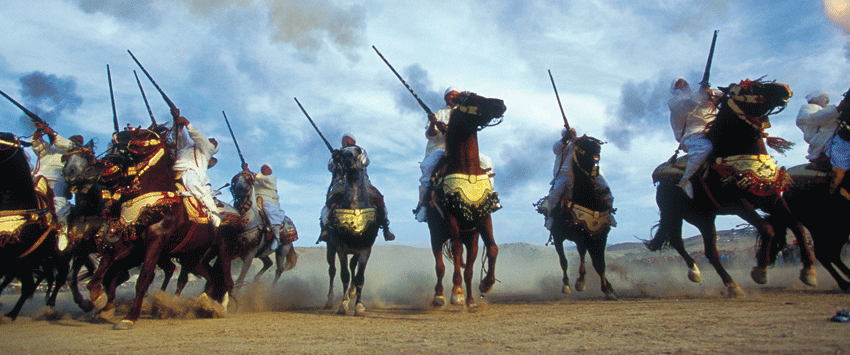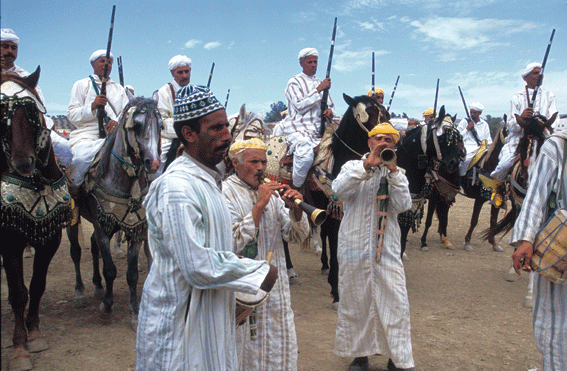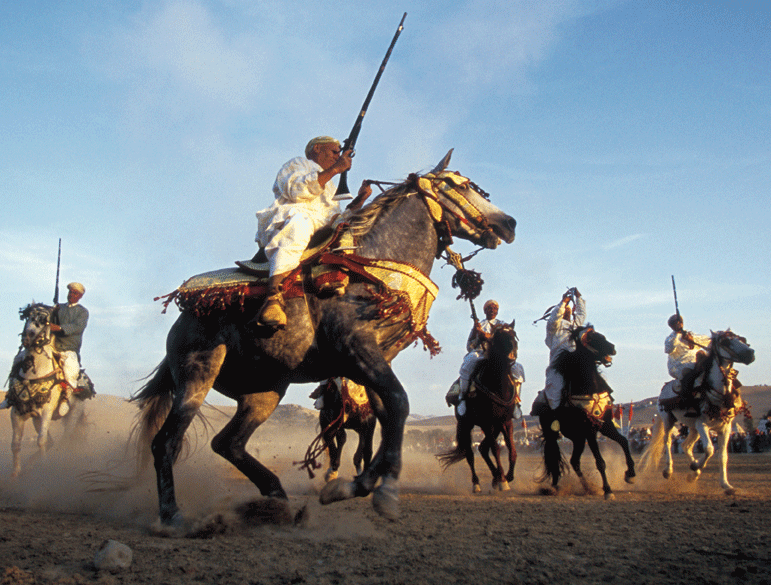
![]() Travel
Travel
Eastern Morocco
The Picturesque Fantasia Festival of Tissa

Proud of their traditions and cavalry skills, Moroccans riders congregate to northeastern Morocco to participate in the yearly Fantasia competitions.
By:By: Irina Prentice
Photo: Mark Shenley
Dust rises in the midst of the thunderous sound of the racing horses. The riders as a unit front, gallop down the filed at full speed. Then, half way down the course, they brace themselves to their beasts, raise their guns; the leader in the group calls out the command, and a simultaneous crack erupts from their Barodes. The smells of gunpowder and musty horses fill the air. Within seconds, the riders reign in their horses. The beast bounce into a stop inches away from the judges’ panel.
 The leader with a nod of the head makes contact with the dignitaries and judges. He will then lead his horsemen to the side making room for the next competitors racing down the course. The team will ride morning to dusk over three or four days.
The leader with a nod of the head makes contact with the dignitaries and judges. He will then lead his horsemen to the side making room for the next competitors racing down the course. The team will ride morning to dusk over three or four days.
The teams are graded on their speed, skill and coordination, as well as the quality of horse and mount and elegance of the riders’ costumes. Over the course of a few days, the judges will make an average of each teams’ performance, and the winners of the different categories will receive prize issue from the Ministry of Agriculture and the Royal Horse Federation.
Once a year, in the autumn, the members of the different Berber tribes of northeast Morocco congregate in Tissa to compete their horses and riding skills in the very picturesque tradition of fantasias.
Tissa nestled in the southern foothills of the Rif Mountains is an hour’s drive east of the imperial city of Fez. The town, which hosts the largest horse festival in the kingdom, is non-descript. Aesthetically it suffers from cheap concrete block buildings and back plastic bags tangled in dry wiry branches of low brush and trees. Yet the vibrant Moroccan sunlight, warm Moroccan welcome and beautiful racecourse generously compensates for the architecturally impoverished appearance of the town.
Along the plain just at the foot of the town is a sprawling dirt racecourse framed by rows of white tents of competing teams and local dignitaries. Tall poles flying the richly colored red and green Moroccan flag are interspersed between the tents, adding to the festive air. Musicians with drums attached to their torsos and flute pipes in their hands walk behind the teams of horsemen making their way up to the beginning of the course. As they play traditional songs, little children follow the troubadours with glee and mischief in their eyes.
The Fantasia competition, embraces both Morocco’s equestrian pride and pastoral roots. Following the agrarian calendar, the horse festival is sandwiched sometime between September and October. It happens and marks the end of the harvest and the beginning of the sowing seasons.
The riders are taught by their father’s who were taught by their fathers the martial art as early as three and four years old. The skilled horsemen practice an art derived from a military practice.
Its historical roots go back as early as when the sedentary Berber tribes of the surrounding area of Fez pledged their allegiance to the Arab King Moulay Idriss, founder of Fez. In return for their allegiance the Moulay Idriss incorporated the Berber horsemen as part of his security personnel. Today, the relationship between the Berber horsemen and the King continues.
In 2003, the first day of the competition was postponed because the riders were summoned to Fez to stand guard while the King Mohamed VI toured the city with President Chirac’s in an open car procession. A few month’s prior, in May 2003, the best riders from Tissa had been once again summoned by the King’s court to ride in celebration of the birth prince Moulay Hassan, Mohamed VI’s newborn son.
In today’s Morocco, fantasias, a great symbol of national pride and wealth, are often held during large celebrations. They not only represent a symbolic re-enactment of the unity between the Berbers tribes and the Arabs, inter-ethnic peace, but they also celebrate the horseman’s skill, speed and control over the horse.
Riders of fantasia are nationally respected. As men of the countryside, they are encouraged by the ministry of agriculture to breed their horses, the Arab-Barb, which is a cross between the horse of Barbary indigenous to the region and the Arabian horse.
“Our horses are the best around”, explains Azzouz with pride. His family has been raising horses for as long as he can remember. The Barbary horse was apparently used in the Roman cavalry.
The horse of Barbary is known for its endurance and strength. The Arabian horse is chosen for its lightness, speed and handsome traits. These beautiful animals like the Fantasia embody the Arab and Berber union.
The province of Tissa is nationally recognized for being one of the oldest breeding grounds of the Moroccan horse ideal for Fantasia riding. The riders clad in yellow handmade goat leather boots with pointed toe, light colored striped jellabas, white turbans ride richly decorated mounts, composed of the gold embroidered chest plates, and intricately woven saddles. The wealth in both the riders dress and mounts are indicative of social status.
The riders of fantasia are the landed gentry of the countryside. “The upkeep of a horse is not a cheap hobby”, says Azzouz. “A horse can cost a man up to 70 dirhams a day. And you need land as well”.
By the evening, as the teams of riders make their way through the crowds amassed along the edge of the field, they regroup to their respective tents where their fathers, uncles, grandfathers visit with fellow competitors and villagers stopping in for tea and a chat.
The festival is not only celebrates impressive horsemanship, but it also represents a time for the neighboring villages to congregate, visit, settle disputes, do business, and arrange marriages. The social and living aspect is an attractive aspect of the festival.
In a world were traditions are being lost or are being repackaged as tourist attractions, the festival of Tissa stands out as a living tradition, which benefits first local communities while giving them a sense of national pride.